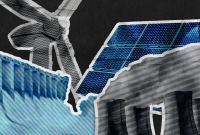Support strong Canadian climate journalism for 2025
Indigenous ownership of electrification projects gets them built faster, and the Government of Ontario has taken note of this.
Ontario recently launched its largest competitive energy procurement, promising to incentivize “economic opportunities for projects with or by Indigenous communities on whose traditional territory the projects are proposed.” The Independent Electricity System Operator's Long Term Procurement (LT2) aims to develop up to 5,000 MW of new power for Ontario, which could lead to mutually beneficial business partnerships with Indigenous nations.
For many provinces and territories, the ramp-up of electrification may seem ambitious. It will be a challenge for Canada to double or triple our electricity supply and grid by 2050, but this task is necessary for the country to stay globally relevant. Further, with a mega-wave of electrification projects cresting the horizon, these projects will be built on Indigenous lands. To achieve electrification goals, it will be advantageous for governments to take measures to support Indigenous-industry partnerships.
Ontario’s — and Canada’s — electrification goals rely on lands and resources to which Indigenous nations are rights-holders. By supporting Indigenous nations to have the option to become project owners, both governments and Indigenous nations can leverage the commercial opportunity of electrification. The question is not if it can be done, but how.
The answer is prioritizing Indigenous ownership in electrification projects.
Indigenous ownership and partnership on projects will de-risk projects for Indigenous nations, industry and lenders alike, by providing certainty and speeding up project timelines. When the path to electrification is built alongside Indigenous nations, it is lined with a stunning commercial opportunity for all of Canada, an anticipated CAD $119.4 billion in capital costs in generation and CAD$27.75 billion in transmission. As this unfolds, Indigenous nations in Canada expect to be full economic beneficiaries.
The positive impact Indigenous nations have on projects is already evident. Two recent Ontario examples are the Chatham to Lakeshore Transmission Line and the Waasigan Transmission Line. These projects are both part of Hydro One’s partnership with local First Nations who hold an option on a 50 per cent equity ownership stake. Five Nations Energy, a fully Indigenous-owned electricity transmission company, is one of only five licensed electricity transmitters in Ontario.
The tools are in place for Ontario to ensure equity ownership is on the table for First Nations: the province already has the Aboriginal Loan Guarantee Program in place for backing Indigenous investments in electricity infrastructure projects. Canada Infrastructure Bank has an Indigenous Equity Initiative that supports Indigenous equity investment, and the Government of Canada has mandated a National Indigenous Loan Guarantee program.
With this in mind, we — the First Nations Major Projects Coalition and Mokwateh — recently released our National Indigenous Electrification Strategy to maximize commercial benefit from electrification in Canada through centering on Indigenous rights and prosperity.
Ontario — and other provinces and territories — are starting to get on track to increase clean power supply and transmission build-out at the rapid rate required. Indigenous nations are key to this acceleration.
But to do this, it needs to be done right. The road to net-zero in partnership with Indigenous nations must include Indigenous consent, governance and options for ownership in projects.
This process has begun. While the country scrambles to expand the electricity supply, Indigenous nations are quickly becoming energy sector leaders. We are now the third-largest collective owners of clean energy assets in the country, after government and utilities.
For Ontario to be successful in this energy procurement, it must implement effective policy, programs and regulations — including support for Indigenous access to capital and capacity support and the meaningful incorporation of free, prior, and informed consent. Ensuring these measures will proactively support Indigenous ownership and partnership in electrification projects.
Although provinces and territories across Canada are at different stages of grid and supply expansion — each with distinct energy markets — one thing connects them: by prioritizing Indigenous involvement, they will not just step towards electrification, they will run.
JP Gladu is principal of Mokwateh and previously served as president and CEO of the Canadian Council for Aboriginal Business (CCAB) from September 2012 until April 2020.
Sharleen Gale is a dedicated Indigenous leader and member of the Fort Nelson First Nation, located in the unceded territories of Treaty 8.








Comments